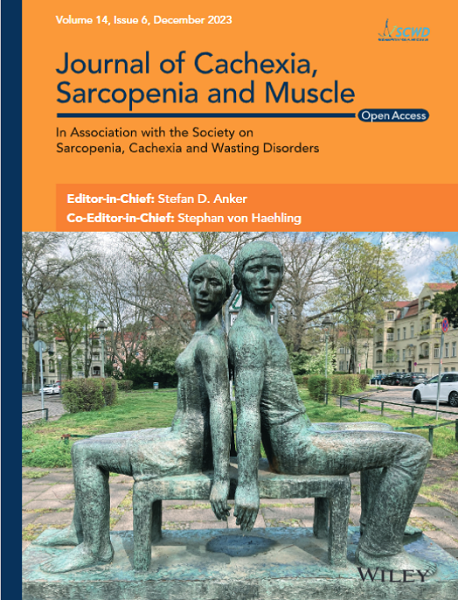摘要
背景很少有研究探讨了与年龄有关的盆底肌肉质量和功能丧失的分子机制--这是导致盆腔器官脱垂和身体健康下降的关键因素。ADP 核糖基化因子 GTPase 激活蛋白 3(ArfGAP3)是 ArfGAPs 的成员之一,它能调节囊泡运输途径和细胞内蛋白质的运输。然而,它对骨骼肌老化的影响在很大程度上仍不为人所知。 方法 以自然老化和 D-gal(D-半乳糖)诱导的老化小鼠模型为研究对象,分析 PFM 的结构、功能和病理变化以及 ArfGAP3 的表达。建立了稳定的 ArfGAP3 敲除和过表达 C2C12 细胞系,以研究 ArfGAP3 的抗衰老作用和衰老过程的内在机制,并辅以 Rab5a 基因干预和 mRFP-GFP-LC3 腺病毒颗粒转染。体内实验包括在小鼠体内过量表达 ArfGAP3 和自噬抑制剂治疗,评估包括组织质量、膀胱漏点压力(BLPP)、亚显微结构、抗氧化应激系统和肌肉再生。 结果 老年(24 个月大)小鼠的 PFM 发生了显著的生理变化,包括肌肉质量下降、横截面积(CSA)减小、支持功能退化(BLPP 降低即可证明)、自噬功能受损和氧化应激水平升高(p < 0.001)。利用老化的 C2C12 模型,我们观察到 D-gal 诱导与细胞衰老、分化受损和线粒体损伤之间存在剂量依赖关系。值得注意的是,ArfGAP3的表达水平在体外和体内老化模型中都明显下调。敲除 ArfGAP3 会加剧老化 C2C12 肌母细胞的分化潜能受损,诱导线粒体形态异常和功能障碍,而 ArfGAP3 的过表达则在很大程度上减轻了这些影响。从机理上讲,我们的发现揭示了 ArfGAP3 和 Rab5a 之间的相互作用,表明它们之间存在协调调控。在细胞衰老和肌肉生成过程中,ArfGAP3介导的与Rab5a相关的自噬和IRS1-AKT-mTOR信号通路的激活被确定,从而导致自噬通量的增强和对氧化应激抵抗力的提高。在体内,ArfGAP3 的过表达可改善 D-gal 诱导的肌肉质量和功能损失,同时促进小鼠的抗氧化反应和肌肉再生。然而,抑制自噬会消除 ArfGAP3 过表达的这些保护作用。 结论 我们的研究揭示了 ArfGAP3 在衰老过程中通过介导 Rab5a 表达激活 IRS1-AKT-mTOR 信号通路和促进自噬,在增强分化能力和线粒体功能方面的重要作用。这些发现凸显了 ArfGAP3 作为治疗靶点的潜力,可用于改善与衰老相关的骨骼肌功能衰退。

Background
Few researches have investigated the molecular mechanism responsible for the age-related loss of the pelvic floor muscle (PFM) mass and functionality—a pivotal contributor to pelvic organ prolapse and diminished physical well-being. ADP ribosylation factor GTPase activating protein 3 (ArfGAP3) is a member of ArfGAPs, which regulates the vesicular trafficking pathway and intracellular proteins transporting. However, its effects on skeletal muscle ageing remain largely unknown.
Methods
Mouse models of natural ageing and D-gal (D-galactose)–induced ageing were subject to analyse the structure, function and pathological alterations of the PFM and the expression of ArfGAP3. Stable ArfGAP3 knockdown and overexpression C2C12 cell lines were established to investigate the anti-senescence effects of ArfGAP3 and the underlying mechanisms in ageing process, complemented by Rab5a genetic intervention and mRFP-GFP-LC3 adenoviral particles transfection. In vivo experiments entailed ArfGAP3 overexpression in mice alongside autophagy inhibitor treatment, with assessments encompassing tissue mass, bladder leak point pressure (BLPP), submicroscopic structure, antioxidative stress system and muscle regeneration.
Results
Aged (24-month-old) mice exhibited significant physiological alterations in PFMs, including decreased muscle mass, diminished cross-sectional area (CSA), deteriorated supporting function (as evidenced by reduced BLPP), impaired autophagy and increased levels of oxidative stress (p < 0.001). Utilizing ageing C2C12 model, we observed a dose-dependent relationship between D-gal induction and cellular senescence, impaired differentiation and mitochondrial damage. Remarkably, the expression levels of ArfGAP3 were markedly downregulated in both in vitro and in vivo ageing models. Knockdown of ArfGAP3 exacerbated impaired differentiation potential and induced aberrant mitochondrial morphology and functional dysfunction in ageing C2C12 myoblasts, whereas ArfGAP3 overexpression largely mitigated these effects. Mechanistically, our findings revealed an interplay between ArfGAP3 and Rab5a, indicating their coordinated regulation. ArfGAP3-mediated activation of Rab5a-associated autophagy and IRS1-AKT-mTOR signalling pathways during cellular senescence and myogenesis was identified, leading to enhanced autophagic flux and improved resistance to oxidative stress. In vivo, ArfGAP3 overexpression ameliorated D-gal–induced loss of muscle mass and function, while promoting antioxidant responses and muscle regeneration in mice. However, these protective effects of ArfGAP3 overexpression were extinguished by autophagy inhibition.
Conclusions
Our study uncovers the significant role of ArfGAP3 in enhancing differentiation capacity and mitochondrial function through mediating Rab5a expression to activate IRS1-AKT-mTOR signalling pathways and promote autophagy during the ageing process. These findings underscore the potential of ArfGAP3 as a promising therapeutic target for ameliorating the decline in skeletal muscle function associated with ageing.

 求助内容:
求助内容: 应助结果提醒方式:
应助结果提醒方式:


